Economy and politics almost always go hand in hand — in simple terms, they influence each other. Thus, by understanding the trends and sentiments in at least one of these areas, you can fairly accurately predict business developments. Just like what happened at the end of 2024.

After the conclusion of one of the year’s major political events — the U.S. elections — business experts are holding their breath. The reason? Promises of deregulation, tax cuts, and potentially lower capital requirements suggest the new U.S. administration could boost market dynamics. This pro-business stance signals a return to policies that previously reduced oversight and allowed financial institutions to thrive.
This anticipation is especially evident in the mergers and acquisitions (M&A) market. The logic is straightforward: the previous steps taken by this administration led to increased investment activity. For instance, the total value of U.S. mergers and acquisitions reached approximately $1.9 trillion in 2018, marking a significant surge from previous years. Analysts predict similar policies could drive growth again, particularly in the banking sector.
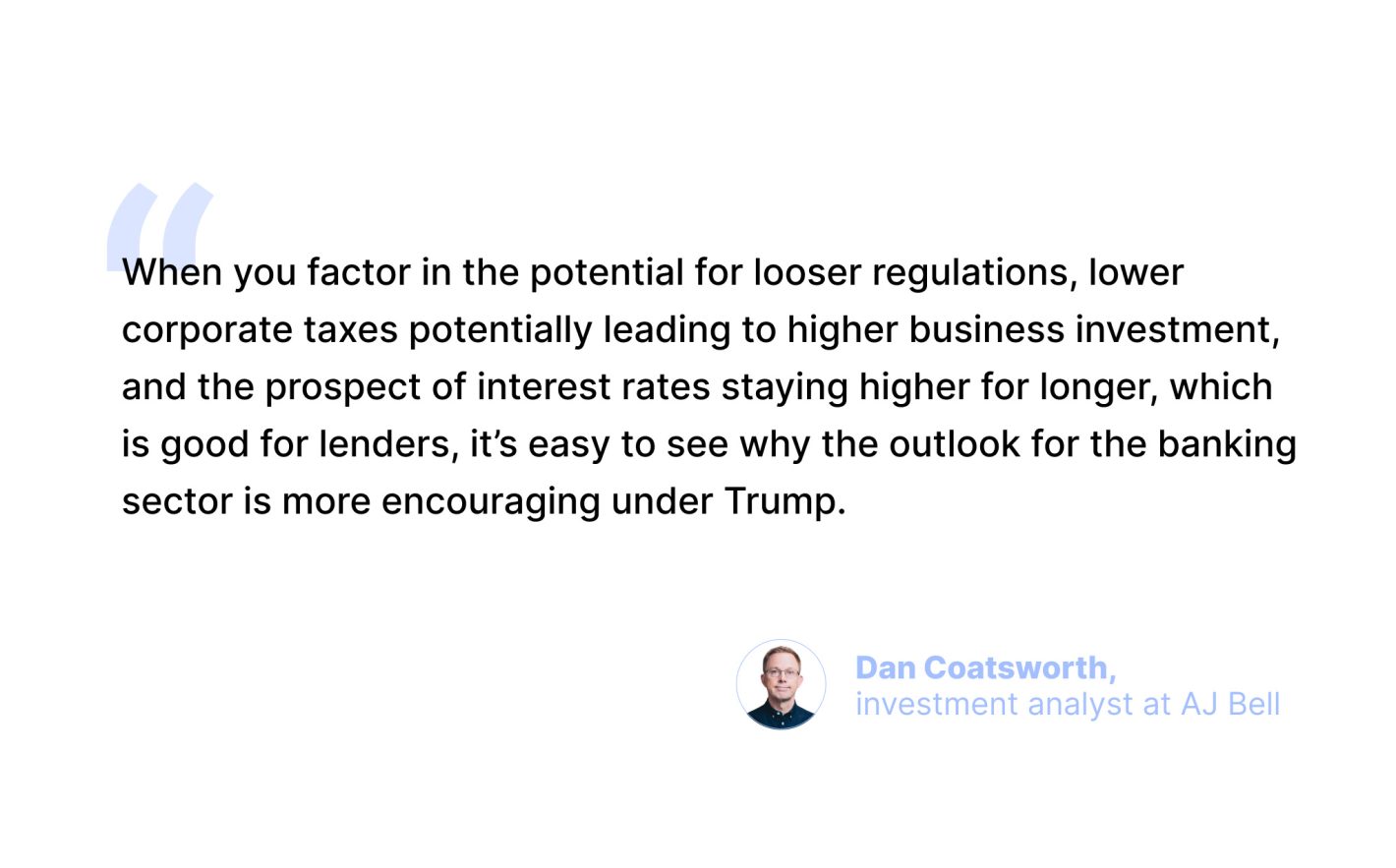


With M&A activity expected to rise, a seamless integration process will be critical to unlocking expected synergies and additional benefits. In this piece, Sombra emphasizes the importance of preparing for the new economic cycle and outlines what companies that are considering or planning mergers and acquisitions in the coming years should be ready for.
What Influences the M&A Deals in 2025?
By all stats, this year can be marked as an M&A recovery one. A recent survey from PwC for CEOs illustrates the sentiment of decision-makers well: 64% of chief executives had not made a major acquisition in the last three years, but 60% of them plan to do so in the next three years.
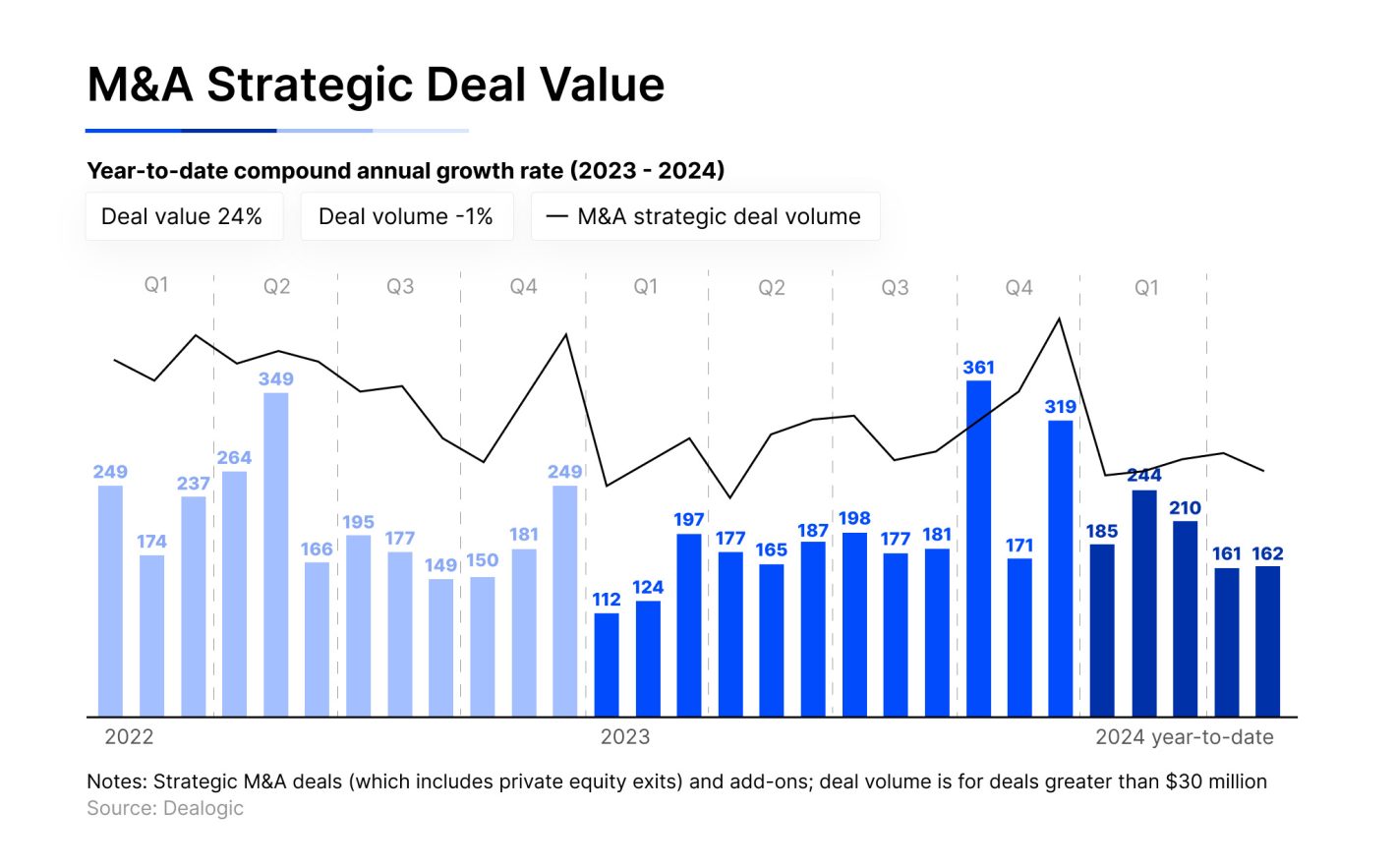


M&A strategic deal value growth 2023-2024
The coming economic environment is expected to foster a wave of M&A integrations across industries, particularly in financial services, asset management, and digital infrastructure. Let’s dive into what’s going on.
Tech’s Taking Center Stage
Everyone’s chasing tech—AI, ML, automation—you name it. Companies are snapping up tech firms to stay ahead as digitalization reshapes industries. The PwC M&A Outlook flags tech as a hotspot for firms racing to acquire cutting-edge capabilities to stay competitive. Post-acquisition integration remains critical, with smooth alignment of strategic goals key to avoiding disruptions.
Industry Consolidation Heats Up



Companies are consolidating for scale, efficiency, and stronger market positioning. Asset and wealth management is a prime example here, with 79 announced AWM deals in the first quarter of 2024 to 70 and 63 announcements in the second and third quarters. Firms are expanding into alternative investments like private credit and infrastructure assets, while some deals stem from older business owners planning retirement.
Private Equity Power Moves
Firms are teaming up for larger, more ambitious deals. Take Creative Planning and Homrich Berg — backed by PE giant TPG — partnering to build market dominance. This trend of pooled resources is reshaping the PE landscape.
The ESG Deal Surge
Companies are actively acquiring assets that align with sustainability goals, attracting value-driven investors while benefiting the planet. Infrastructure investments, offering both long-term returns and sustainability impact, are a prime example of driving deal activity.
Cross-Border Expansion
Why stay local when you can scale globally? More companies are expanding internationally to unlock growth. US firms, for instance, are eyeing Europe as regulatory shifts make cross-border deals easier. The tech sector is especially hot, with businesses acquiring capabilities to extend their reach in regions like the EU and Africa.
Notable Transactions and Strategic Directions of 2024
2024 has seen a series of high-profile mergers and acquisitions highlighting the importance of scaling operations, expanding into high-growth sectors, and diversifying portfolios.
BlackRock’s Acquisition of Global Infrastructure Partners (GIP)



In a move that consolidates over $170 billion in assets under management, BlackRock completed its acquisition of GIP (Global Infrastructure Partners). This deal positions BlackRock as a global leader in infrastructure investment, with operations in more than 100 countries. Laurence Fink, BlackRock’s CEO, aptly described the transaction as a response to “structural trends driving growth in infrastructure.”
The acquisition is expected to enhance private markets by around 40% and create $750 million in annual management fees. By integrating GIP’s expertise in equity, debt, and solutions, BlackRock aims to capitalize on long-term infrastructure trends and provide superior investment opportunities to clients.
Stonepeak’s Acquisition of Boundary Street Capital



Stonepeak, a leading investment firm, expanded its footprint in digital infrastructure and technology services by acquiring Boundary Street Capital. This deal underscores the growing importance of AI adoption and cloud-based technologies as transformative forces in global markets.
Boundary Street’s focus on digital infrastructure, enterprise software, and managed services complements Stonepeak’s portfolio. Jack Howell, Co-President of Stonepeak, emphasized the strategic alignment, stating, “The acquisition strengthens our capabilities in AI-driven businesses and positions us to execute efficiently on emerging opportunities.”
Waverly Advisors Acquiring Buckingham Advisors



Waverly’s acquisition of Buckingham Advisors exemplifies the strategic value of combining tax planning with investment management services. This partnership added $900 million to Waverly’s AUM and expanded its footprint across Ohio with four new locations.
Jay Buckingham, Regional Director at Waverly, highlighted the collaborative potential: “This partnership provides significant resources and infrastructure, allowing us to focus on what matters most—our clients.”
This deal reflects the importance of diversification and integrated solutions in wealth management, particularly as firms face growing competition and changing client expectations.
Some of Our Insights
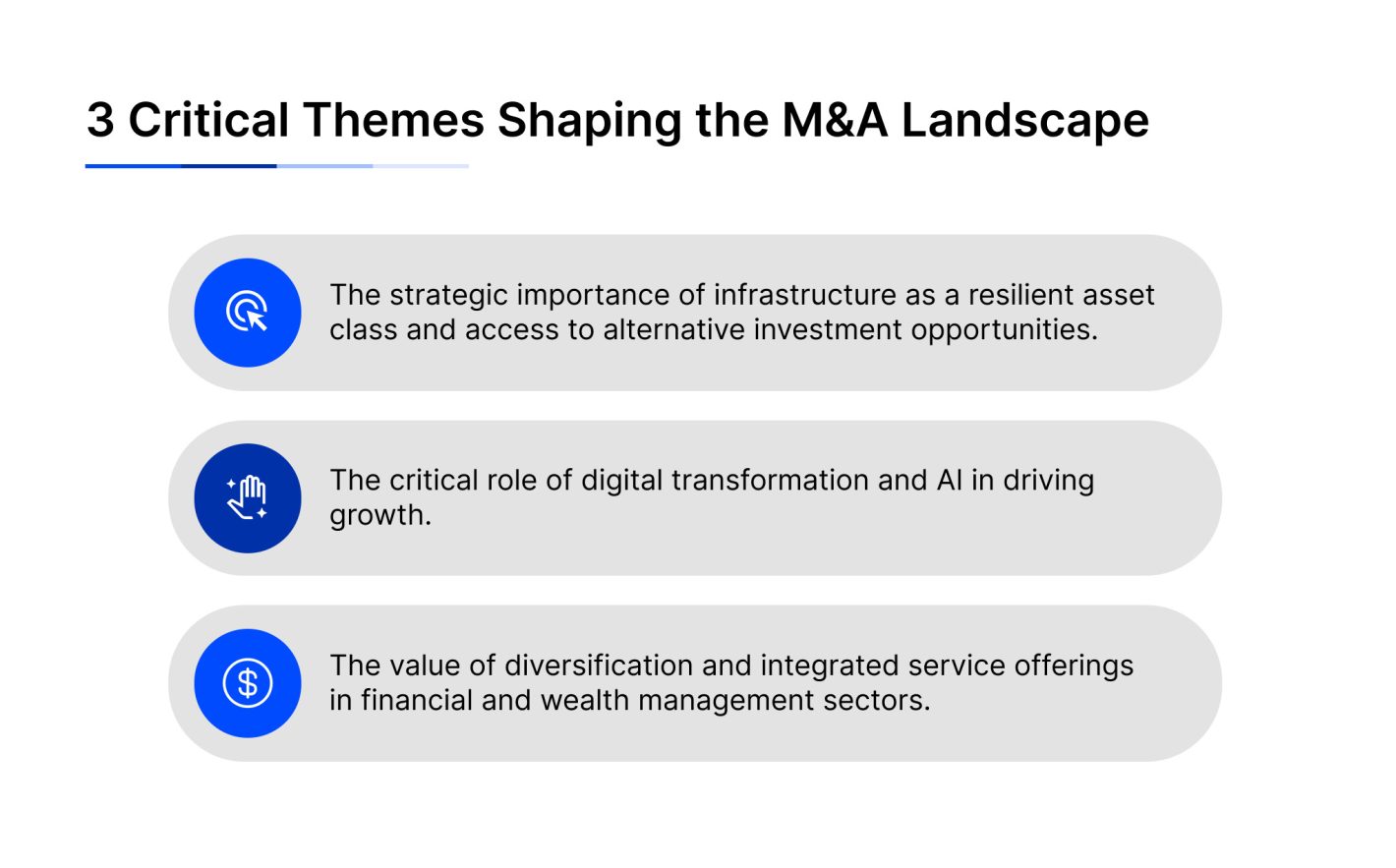


Critical themes shaping the M&A landscape
These transactions underscore three critical themes shaping the M&A landscape:
- The strategic importance of infrastructure as a resilient asset class and access to alternative investment opportunities.
- The critical role of digital transformation and AI in driving growth.
- The value of diversification and integrated service offerings in financial and wealth management sectors.
M&A Typical Challenges
Despite booming M&A activity, failure rates remain stubbornly high—up to 90% of deals don’t deliver the promised results.
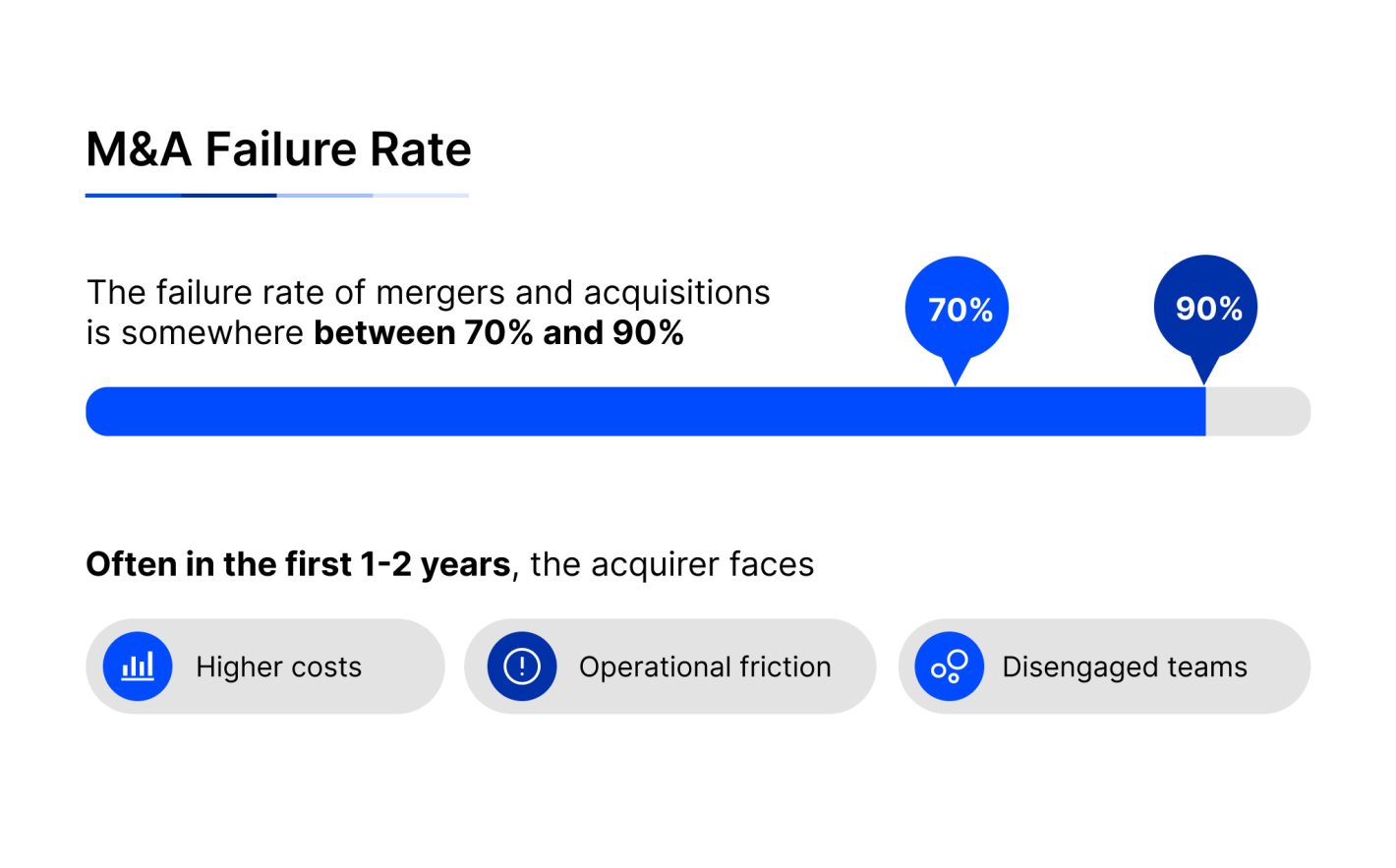


M&A failure rate
Companies often enter integrations with bold synergy projections, only to face higher costs, operational friction, and disengaged teams within the first two years. Why does this keep happening?
1. Due Diligence
Insufficient investigation into a target company’s financial health, legal obligations, and operational aspects can lead to unforeseen liabilities and integration issues. Comprehensive due diligence is essential to identify potential risks and ensure informed decision-making.
2. Regulatory and Legal Hurdles
Navigating complex legal and regulatory landscapes, including antitrust laws and compliance requirements, can delay or derail deals. Early engagement with legal experts and regulatory bodies is crucial to anticipate and address these challenges.
3. Inflated Synergy Projections
In the heat of deal negotiations, financial models often prioritize justifying the price over realistic outcomes. Projected cost savings and revenue growth can overlook the messiness of integration — clashing processes, incompatible systems, and unforeseen operational complexities. What looks profitable in a spreadsheet can unravel quickly under real-world conditions.
4. Culture and Pace
Cultural clashes sink more deals than poor strategy. Imagine merging a fast-moving startup with a process-driven corporate giant—what works for one can stifle the other. Differences in decision-making styles, leadership structures, and employee expectations often lead to friction, trust issues, and stalled progress. Companies underestimate how deeply culture impacts performance until tensions start slowing everything down.
5. People
Deals are often closed before employee impact is considered. Yet people—not financial models—determine whether a merger thrives or flops. Lack of clarity on job roles, career paths, and even basic job security can create a productivity slump. Without proactive communication and leadership involvement, morale suffers and key talent starts walking out the door.
At Sombra, we’ve had the opportunity to support the IT integration phase for two major financial institutions during their post-M&A transitions. Our focus on technical migration allowed us to uncover key lessons that drive successful integrations.
Here’s our perspective on how to approach M&A integration the right way — by aligning strategy, people, and processes for long-term success. And remember that M&A integration can cost up to 7% of the deal value, regardless of deal size. Notably, larger deals valued above $10 billion often incur lower average integration costs as a percentage of the deal value compared to smaller deals.
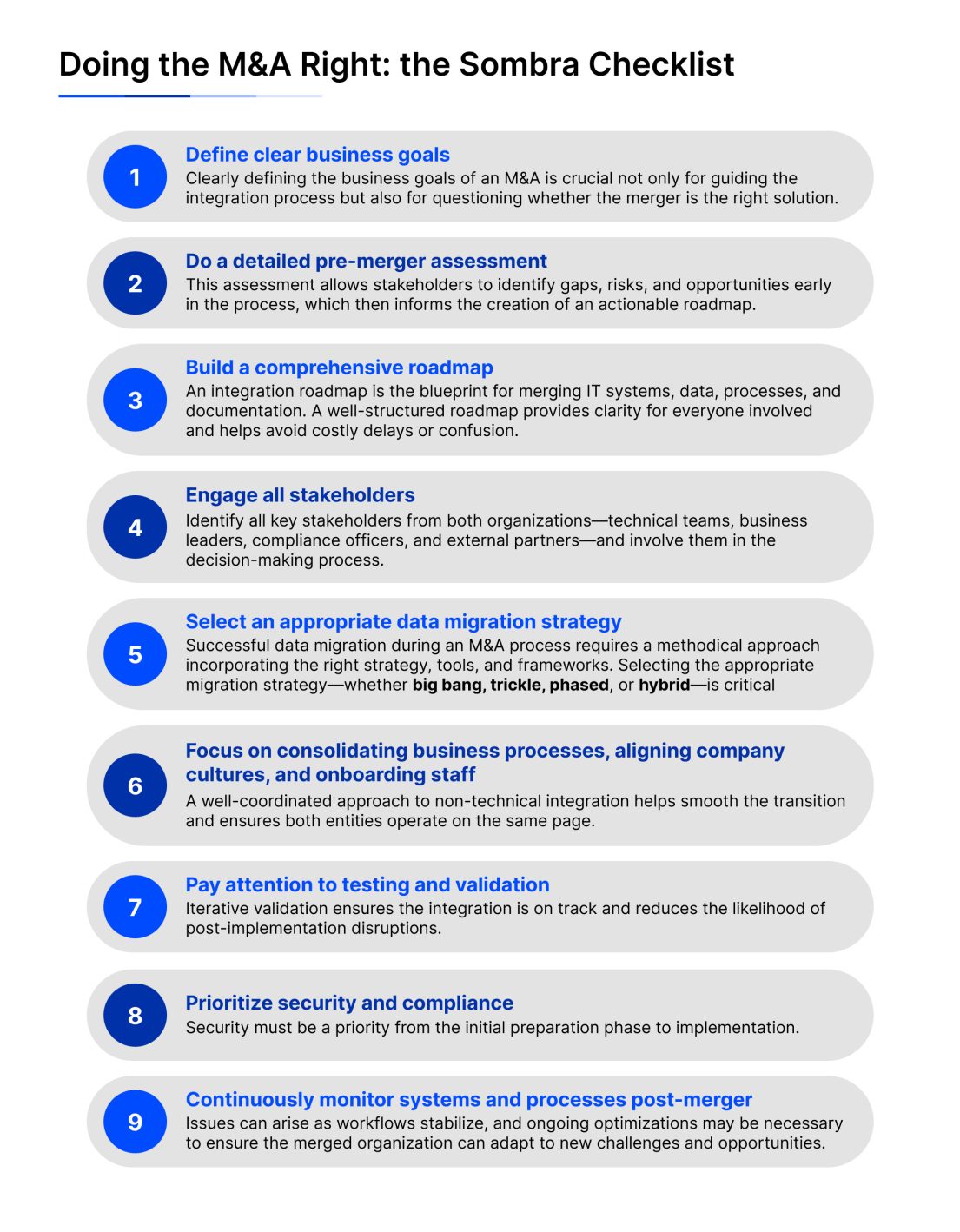


M&A deal checklist
Justify M&A by defining clear business goals
Clearly defining the business goals of an M&A is crucial not only for guiding the integration process but also for questioning whether the merger is the right solution. Goals such as market expansion, operational efficiency, or cost synergies must be carefully evaluated against the organization’s strategic vision and alternatives. By identifying specific outcomes and measurable success criteria, businesses can better assess whether an M&A aligns with their objectives or if alternatives like strategic partnerships, joint ventures, or organic growth could achieve similar results with less complexity and risk.
This clarity helps avoid unnecessary investments in a merger that may not deliver the desired value. Instead, it ensures the organization pursues the most effective strategy to meet its goals, whether through M&A or other avenues.
Preparation is Key
The foundation of a successful IT integration lies in thorough preparation. A detailed pre-merger assessment is critical. This should include:
- A comprehensive inventory of IT systems, applications, and infrastructure.
- An in-depth review of business processes, workflows, and their dependencies.
- Evaluation of organizational structures and technical documentation from both entities.
This assessment allows stakeholders to identify gaps, risks, and opportunities early in the process, which then informs the creation of an actionable roadmap.
Build a Comprehensive Roadmap
An integration roadmap acts as the blueprint for merging IT systems, data, processes, and documentation. It should define:
- Clear milestones and timelines for unifying IT systems.
- Specific strategies for data migration to ensure consistency and accuracy.
- Plans for aligning operational processes and consolidating documentation.
A well-structured roadmap provides clarity for everyone involved and helps avoid costly delays or confusion.
Engage All Stakeholders
One of the most overlooked aspects of IT integration is ensuring cross-functional collaboration. Identify all key stakeholders from both organizations—technical teams, business leaders, compliance officers, and external partners—and involve them in the decision-making process. A cohesive integration team fosters alignment across priorities and ensures no critical perspective is overlooked.
Data migration is at the heart of the M&A process
Successful data migration during an M&A process requires a methodical approach that incorporates the right strategy, tools, and frameworks. Selecting the appropriate migration strategy—whether big bang, trickle, phased, or hybrid—is critical:
- Big bang: migrates all data at once for a fast transition but involves higher risk and extensive testing.
- Trickle: gradually moves small portions of data, enabling real-time validation and reduced downtime.
- Phased: breaks the migration into stages, reducing complexity and allowing incremental progress.
- Hybrid: combines strategies to tailor solutions for critical and non-critical data streams.
The data governance framework is crucial for ensuring the migration process is secure, compliant, and reliable. This includes:
- Clear roles and responsibilities: defining data owners, custodians, and users across both organizations.
- Security protocols: implementing encryption, secure access controls, and audit trails to protect sensitive data.
- Compliance alignment: meeting regulatory standards such as GDPR, CCPA, or PCI DSS.
Additionally, using the right migration tools is vital to streamline the process. These tools should offer:
- Automation: reducing manual effort and minimizing errors.
- Compatibility: supporting both legacy and target systems.
- Data transformation: reformatting data to align with the new environment.
- Testing features: validating data accuracy and consistency before execution.
By combining these strategies, governance practices, and tools, organizations can execute a seamless migration, mitigate risks, and establish a unified data platform that supports post-merger growth and operational efficiency.
M&A is About More Than IT migration
While IT integration is a significant component of M&A, it’s equally important to focus on consolidating business processes, aligning company cultures, and onboarding staff. A coordinated non-technical integration approach eases the transition and ensures both entities operate in alignment.
Prioritize Testing and Validation
The importance of a robust testing strategy cannot be overstated. Testing should encompass:
- Functional testing to verify that systems and processes work as expected.
- Stress testing to ensure the scalability and performance of unified systems under load.
- Security testing to safeguard against vulnerabilities.
This iterative validation ensures the integration is on track and reduces the likelihood of post-implementation surprises.
Security and Compliance are Non-Negotiable
In the financial sector, regulatory compliance and security are paramount. From the initial preparation phase through to implementation, security must be a priority. Considerations include:
- Aligning with industry-specific regulations, such as GDPR, PCI DSS, or local data protection laws.
- Conducting penetration tests and audits to identify vulnerabilities.
- Ensuring all data migrations are conducted securely to protect sensitive customer information.
Integration is Just the Beginning
Finally, completing the technical migration doesn’t mean the process is over. Post-integration, the systems and processes must be monitored continuously. Issues can arise as workflows stabilize, and ongoing optimizations may be necessary to ensure the merged organization can adapt to new challenges and opportunities.



In Summary
Migrating IT systems, data, and processes during a financial sector M&A is a complex yet achievable task when approached with a methodical plan. By prioritizing justification, preparation, data migration strategy, security, stakeholder alignment, and testing, organizations can minimize risk, ensure compliance, and build a unified platform that supports their post-merger objectives.
These lessons serve as a testament to the importance of strategic thinking and careful execution during IT integration. At Sombra, we help businesses to make their journeys less challenging. Whether it’s preparing for a merger, managing integration, or tackling IT complexities, we’re here to make your M&A journey smoother and more successful.
Ready to achieve transformational results in your M&A journey? Contact Sombra to explore how our expertise can drive the success of your next deal.











